

In 1982, Ray went to Lake Waramaug to run against some of the best ultrarunners in the country. He didn’t have the highest expectations because he had not fully recovered from running a 2:28 at the Boston Marathon just 13 days earlier. He said, “I entered confidently, figuring to finish in the top ten. Nevertheless, I had some misgivings. But by the marathon point (2:37) I felt very smooth and moved easily beyond Stu Mittleman (1951-) and then George Gardiner (1942-).” (Nick Marshall, 1982 Ultradistance Summary, 26). Ray went on to win the 50-miler in 5:17:14.
In 1983 Ray dueled it out with legend Stu Mittleman (1951-) in the Knickerbocker 60K in Central Park. Ray explained, “We introduced ourselves and had a lengthy conversation as we watched the day emerge from a dark, drizzly, gray to a bright and beautiful afternoon. What a thrill to run in Central Park in early spring. We weren’t racing. Two miles from the finish, I was forced to seek comfort in the shrubbery. Mittleman went on to win by 61 seconds over Ray. (Marshall, 1983 Ultradistance Summary, 22).
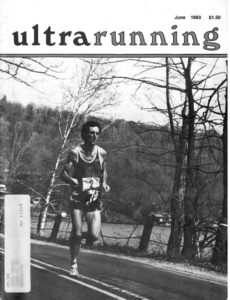
In 1983, he again won the Lake Waramaug 50-miler in 5:17 and continued on to complete 100K in 6:57, dueling it out with Ray Krolewicz (1955-). There were 138 runners in the race that year. That began “the battle of the Rays” at Lake Waramaug for multiple years. His 100K performance put him on the cover of Ultrarunning Magazine. Asked once if running ultras hurt he replied, “You go through many patches where you don’t want to go on. You just really, really hurt and you get depressed. But they pass. You just endure. You have to operate on faith that they do pass.”
In June, 1983, Ray competed in the TAC 100 Mile Championship at Shea Stadium with 84 runners. The field was highly competitive with 19 runners who had run sub-6-hour 50-milers. The race started at 6 p.m. on the course that ran both inside the stadium and out in the parking lot. A group of runners took off like a shot at 6-minute pace. Twenty-seven runners ran the first mile in under 7:30. But most of the rabbits crashed and burned early on, including Mittleman, who dropped at 57 miles. Only four of those elite 50-mile runners finished the race. Ray hit the 50-mile mark in an outstanding 5:57 but was struggling. He was running in first place but admitted that if anyone would have passed him by 100K, he would have dropped out. Ray wrote of the experience, “Where else could an inveterate baseball fan gain the opportunity to frolic in such a setting? And to endure pain, anguish and self-doubt to such a degree that, yes, at least on this occasion, I approached being the hero of my own life.” (Marshall, 1983 Ultradistance Summary, 40).
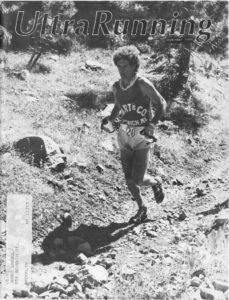

Ray finished in first with his lifetime best time for 100 miles, 13:16:02. He said, “Then to finish and feel for all the world like dancing. I leaped into the air at the tape.” At that time, it was thought to be the third fastest American time in the 100. miler. While the race was underway, Dan Brannen (1953-), the course certifier, came by and noticed that the cones out in the parking lot were not set up correctly. He measured it with his bicycle and discovered that the one-mile-loop was 22 yards long. The race officials decided to not adjust the course to the correct length mid-race, so the length ended out to be 101.25 miles, but finish times were adjusted.
Also that year, Ray competed internationally in the 1983 London to Brighton (52 miles) and finished in 21th place, with 6:03:56.
Ray next embraced the trails, running the 1987 Old Dominion 100 in Virginia. At about mile 25, Ray with two other leaders got off course. Their error was caught before they went too far and they returned with more determination after the extra miles. He had a good excuse because he was color blind, making it tough to detect the colors of the course markings. By mile 50, it was a race between Ray and Stephen Tucker (1953-). Ray prevailed for the win, with 18:53.
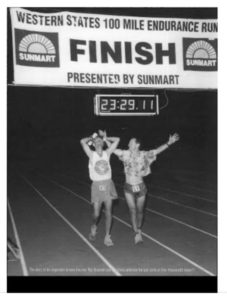

In 1988, Ray started his legendary Western States 100 career. He would finish Western States 12 times from 1988 to 2003. His best finish was in 1992 when he finished in 2nd place, with 17:27:54. His 10th finish came in 1999 with his buddy, Billy Davis (1946-). Ray said, “Those were the most emotional steps I have ever taken. Nothing like it, nothing.” (phone call with Andy Jones-Wilkins, see 2015 IRunFar article about Ray).
Ray, now in love with running on the mountain trails, moved to California in 1990 to run the trails in the Sierra Nevada Mountains. That year, he ran in the 100K World Championships held at the Edmund Fitzgerald 100K, in Duluth, Minnesota. It has been referred to as “The Greatest 100K Road Race in History.” Ray placed 20th with a time of 7:48:17.
In 1993, at age 43, Ray ran in the inaugural Rocky Raccoon 100 in Huntsville Stake Park in Texas. He came in second with 15:54:55. After he finished, he returned several hours later to pace another runner to their first 100-mile finish.
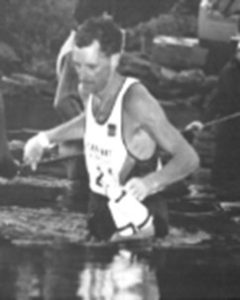

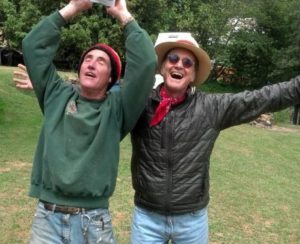

Ray continued running ultras or shorter races at least until 2012, at the age of 63. His wife, Joan, was also an accomplished ultrarunner. She has finished Western States 11 times. In his final years, Ray suffered from Parkinson’s and dementia, and passed away at the age of 74.
